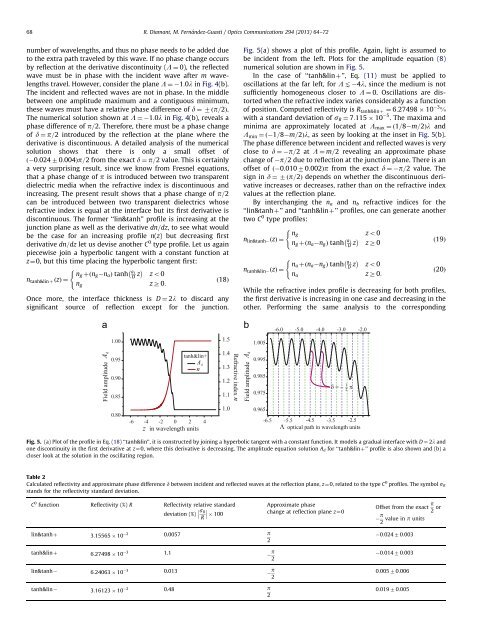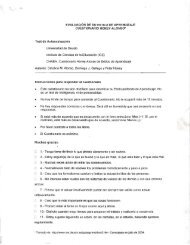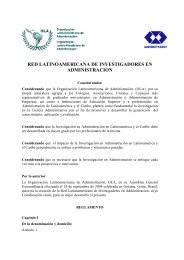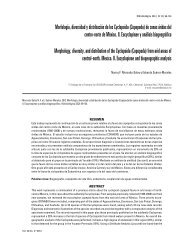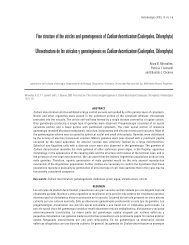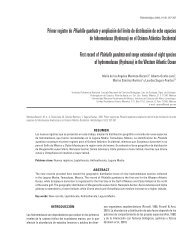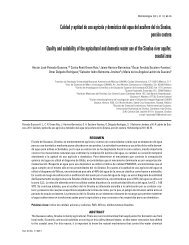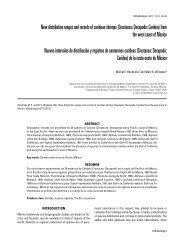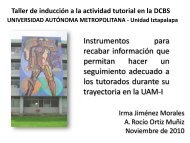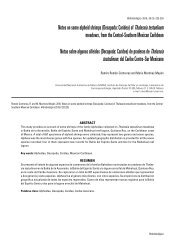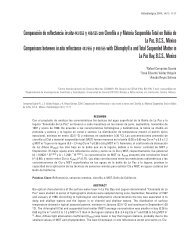Phase change of light reflected by a discontinuity in the derivatives ...
Phase change of light reflected by a discontinuity in the derivatives ...
Phase change of light reflected by a discontinuity in the derivatives ...
Create successful ePaper yourself
Turn your PDF publications into a flip-book with our unique Google optimized e-Paper software.
68R. Diamant, M. Fernández-Guasti / Optics Communications 294 (2013) 64–72number <strong>of</strong> wavelengths, and thus no phase needs to be added dueto <strong>the</strong> extra path traveled <strong>by</strong> this wave. If no phase <strong>change</strong> occurs<strong>by</strong> reflection at <strong>the</strong> derivative <strong>discont<strong>in</strong>uity</strong> (L ¼ 0), <strong>the</strong> <strong>reflected</strong>wave must be <strong>in</strong> phase with <strong>the</strong> <strong>in</strong>cident wave after m wavelengthstravel. However, consider <strong>the</strong> plane L ¼ 1:0l <strong>in</strong> Fig. 4(b).The <strong>in</strong>cident and <strong>reflected</strong> waves are not <strong>in</strong> phase. In <strong>the</strong> middlebetween one amplitude maximum and a contiguous m<strong>in</strong>imum,<strong>the</strong>se waves must have a relative phase difference <strong>of</strong> d ¼ 7ðp=2Þ.The numerical solution shown at L ¼ 1:0l <strong>in</strong> Fig. 4(b), reveals aphase difference <strong>of</strong> p=2. Therefore, <strong>the</strong>re must be a phase <strong>change</strong><strong>of</strong> d ¼ p=2 <strong>in</strong>troduced <strong>by</strong> <strong>the</strong> reflection at <strong>the</strong> plane where <strong>the</strong>derivative is discont<strong>in</strong>uous. A detailed analysis <strong>of</strong> <strong>the</strong> numericalsolution shows that <strong>the</strong>re is only a small <strong>of</strong>fset <strong>of</strong>ð 0:02470:004Þp=2 from <strong>the</strong> exact d ¼ p=2 value. This is certa<strong>in</strong>lya very surpris<strong>in</strong>g result, s<strong>in</strong>ce we know from Fresnel equations,that a phase <strong>change</strong> <strong>of</strong> p is <strong>in</strong>troduced between two transparentdielectric media when <strong>the</strong> refractive <strong>in</strong>dex is discont<strong>in</strong>uous and<strong>in</strong>creas<strong>in</strong>g. The present result shows that a phase <strong>change</strong> <strong>of</strong> p=2can be <strong>in</strong>troduced between two transparent dielectrics whoserefractive <strong>in</strong>dex is equal at <strong>the</strong> <strong>in</strong>terface but its first derivative isdiscont<strong>in</strong>uous. The former ‘‘l<strong>in</strong>&tanh’’ pr<strong>of</strong>ile is <strong>in</strong>creas<strong>in</strong>g at <strong>the</strong>junction plane as well as <strong>the</strong> derivative dn=dz, to see what wouldbe <strong>the</strong> case for an <strong>in</strong>creas<strong>in</strong>g pr<strong>of</strong>ile n(z) but decreas<strong>in</strong>g firstderivative dn=dz let us devise ano<strong>the</strong>r C 0 type pr<strong>of</strong>ile. Let us aga<strong>in</strong>piecewise jo<strong>in</strong> a hyperbolic tangent with a constant function atz¼0, but this time plac<strong>in</strong>g <strong>the</strong> hyperbolic tangent first:(n tanh&l<strong>in</strong> þ ðzÞ¼ n g þðn g n a Þ tanh a 1Dz zo0ð18ÞzZ0:n gOnce more, <strong>the</strong> <strong>in</strong>terface thickness is D ¼ 2l to discard anysignificant source <strong>of</strong> reflection except for <strong>the</strong> junction.Fig. 5(a) shows a plot <strong>of</strong> this pr<strong>of</strong>ile. Aga<strong>in</strong>, <strong>light</strong> is assumed tobe <strong>in</strong>cident from <strong>the</strong> left. Plots for <strong>the</strong> amplitude equation (8)numerical solution are shown <strong>in</strong> Fig. 5.In <strong>the</strong> case <strong>of</strong> ‘‘tanh&l<strong>in</strong>þ’’, Eq. (11) must be applied tooscillations at <strong>the</strong> far left, for Lt 4l, s<strong>in</strong>ce <strong>the</strong> medium is notsufficiently homogeneous closer to L ¼ 0. Oscillations are distortedwhen <strong>the</strong> refractive <strong>in</strong>dex varies considerably as a function<strong>of</strong> position. Computed reflectivity is R tanh&l<strong>in</strong> þ ¼ 6:27498 10 3 %with a standard deviation <strong>of</strong> s R ¼ 7:115 10 5 . The maxima andm<strong>in</strong>ima are approximately located at L max ¼ð1=8 m=2Þl andL m<strong>in</strong> ¼ð 1=8 m=2Þl, as seen <strong>by</strong> look<strong>in</strong>g at <strong>the</strong> <strong>in</strong>set <strong>in</strong> Fig. 5(b).The phase difference between <strong>in</strong>cident and <strong>reflected</strong> waves is veryclose to d ¼ p=2 atL ¼ m=2 reveal<strong>in</strong>g an approximate phase<strong>change</strong> <strong>of</strong> p=2 due to reflection at <strong>the</strong> junction plane. There is an<strong>of</strong>fset <strong>of</strong> ð 0:01070:002Þp from <strong>the</strong> exact d ¼ p=2 value. Thesign <strong>in</strong> d ¼ 7ðp=2Þ depends on whe<strong>the</strong>r <strong>the</strong> discont<strong>in</strong>uous derivative<strong>in</strong>creases or decreases, ra<strong>the</strong>r than on <strong>the</strong> refractive <strong>in</strong>dexvalues at <strong>the</strong> reflection plane.By <strong>in</strong>terchang<strong>in</strong>g <strong>the</strong> n a and n b refractive <strong>in</strong>dices for <strong>the</strong>‘‘l<strong>in</strong>&tanhþ’’ and ‘‘tanh&l<strong>in</strong>þ’’ pr<strong>of</strong>iles, one can generate ano<strong>the</strong>rtwo C 0 type pr<strong>of</strong>iles:(n l<strong>in</strong>&tanh ðzÞ¼ n g zo0n g þðn a n g Þ tanh a 1Dz ð19ÞzZ0(n tanh&l<strong>in</strong> ðzÞ¼ n a þðn a n g Þ tanh a 1Dz n azo0zZ0:ð20ÞWhile <strong>the</strong> refractive <strong>in</strong>dex pr<strong>of</strong>ile is decreas<strong>in</strong>g for both pr<strong>of</strong>iles,<strong>the</strong> first derivative is <strong>in</strong>creas<strong>in</strong>g <strong>in</strong> one case and decreas<strong>in</strong>g <strong>in</strong> <strong>the</strong>o<strong>the</strong>r. Perform<strong>in</strong>g <strong>the</strong> same analysis to <strong>the</strong> correspond<strong>in</strong>gFig. 5. (a) Plot <strong>of</strong> <strong>the</strong> pr<strong>of</strong>ile <strong>in</strong> Eq. (18) ‘‘tanh&l<strong>in</strong>’’, it is constructed <strong>by</strong> jo<strong>in</strong><strong>in</strong>g a hyperbolic tangent with a constant function. It models a gradual <strong>in</strong>terface with D ¼ 2l andone <strong>discont<strong>in</strong>uity</strong> <strong>in</strong> <strong>the</strong> first derivative at z¼0, where this derivative is decreas<strong>in</strong>g. The amplitude equation solution A d for ‘‘tanh&l<strong>in</strong>þ’’ pr<strong>of</strong>ile is also shown and (b) acloser look at <strong>the</strong> solution <strong>in</strong> <strong>the</strong> oscillat<strong>in</strong>g region.Table 2Calculated reflectivity and approximate phase difference d between <strong>in</strong>cident and <strong>reflected</strong> waves at <strong>the</strong> reflection plane, z¼0, related to <strong>the</strong> type C 0 pr<strong>of</strong>iles. The symbol s Rstands for <strong>the</strong> reflectivity standard deviation.C 0 function Reflectivity (%) R Reflectivity relative standarddeviation (%) s R 100Rl<strong>in</strong>&tanhþ 3:15565 10 2 0.0057 p2tanh&l<strong>in</strong>þ 6:27498 10 3 1.1 p2l<strong>in</strong>&tanh 6:24063 10 3 0.013 p2tanh&l<strong>in</strong> 3:16123 10 2 0.48 p2Approximate phase<strong>change</strong> at reflection plane z¼0Offset from <strong>the</strong> exact p 2 orpvalue <strong>in</strong> p units20:02470:0030:01470:0030:00570:0060:01970:005


